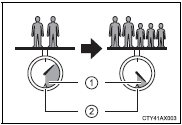Toyota Corolla (E170) 2014–2019 Owners Manual / Driving / Before driving / Cargo and luggage / Calculation formula for your vehicle
Toyota Corolla (E170): Calculation formula for your vehicle
1 Cargo capacity
2 Total load capacity (vehicle capacity weight)

When 2 people with the combined weight of A lb. (kg) are riding in your vehicle, which has a total load capacity (vehicle capacity weight) of B lb. (kg), the available amount of cargo and luggage load capacity will be C lb. (kg) as follows:
B*2 lb. (kg) - A*1 lb. (kg) = C*3 lb. (kg)
*1: A =Weight of people *2: B =Total load capacity *3: C =Available cargo and luggage load
In this condition, if 3 more passengers with the combined weight of D lb. (kg) get on, the available cargo and luggage load will be reduced E lb. (kg) as follows:
C lb. (kg) - D*4 lb. (kg) = E*5 lb. (kg)
*4: D =Additional weight of people *5: E =Available cargo and luggage load
As shown in the example above, if the number of occupants increases, the cargo and luggage load will be reduced by an amount that equals the increased weight due to the additional occupants. In other words, if an increase in the number of occupants causes an excess of the total load capacity (combined weight of occupants plus cargo and luggage load), you must reduce the cargo and luggage on your vehicle.
CAUTION
■Things that must not be carried in the trunk
The following things may cause a fire if loaded in the trunk:
●Receptacles containing gasoline ●Aerosol cans
■Storage precautions
Observe the following precautions.
Failure to do so may prevent the pedals from being depressed properly, may block the driver’s vision, or may result in items hitting the driver or passengers, possibly causing an accident.
●Stow cargo and luggage in the trunk whenever possible.
●To prevent cargo and luggage from sliding forward during braking, do not stack anything in the enlarged trunk. Keep cargo and luggage low, as close to the floor as possible.
●Do not place cargo or luggage in or on the following locations.
• At the feet of the driver
• On the front passenger or rear seats (when stacking items)
• On the package tray
• On the instrument panel
• On the dashboard
• Tray that has no lid
●Secure all items in the occupant compartment.
●When you fold down the rear seats, long items should not be placed directly behind the front seats.
●Never allow anyone to ride in the enlarged trunk. It is not designed for passengers. They should ride in their seats with their seat belts properly fastened.
■Capacity and distribution
●Do not exceed the maximum axle weight rating or the total vehicle weight rating.
●Even if the total load of occupant's weight and the cargo load is less than the total load capacity, do not apply the load unevenly. Improper loading may cause deterioration of steering or braking control which may cause death or serious injury.
Other materials:
Door control transmitter
Registration
1. Registration of recognition code
Hint:
the add mode is used to retain the already registered codes while
registering a new recognition code.
This mode is used when adding a transmitter. If the number of the registered
codes exceeds 4, the
previously registered code wi ...
Automatic air conditioning system
Air outlets are automatically selected and fan speed is automatically
adjusted according to the set temperature setting.
Also, the display and button positions will differ depending on
the type of the system.
Air conditioning controls
Temperature control switch
Fan speed control switch
"A/C" s ...
Circuit description
Refer to dtc c0200/31, c0205/32, c1235/35, c1236/36
Hint:
Dtc no. C0210/33, c1238/38 is for the right rear speed sensor.
Dtc no. C0215/34, c1239/39 is for the left rear speed sensor.
Wiring diagram
...


